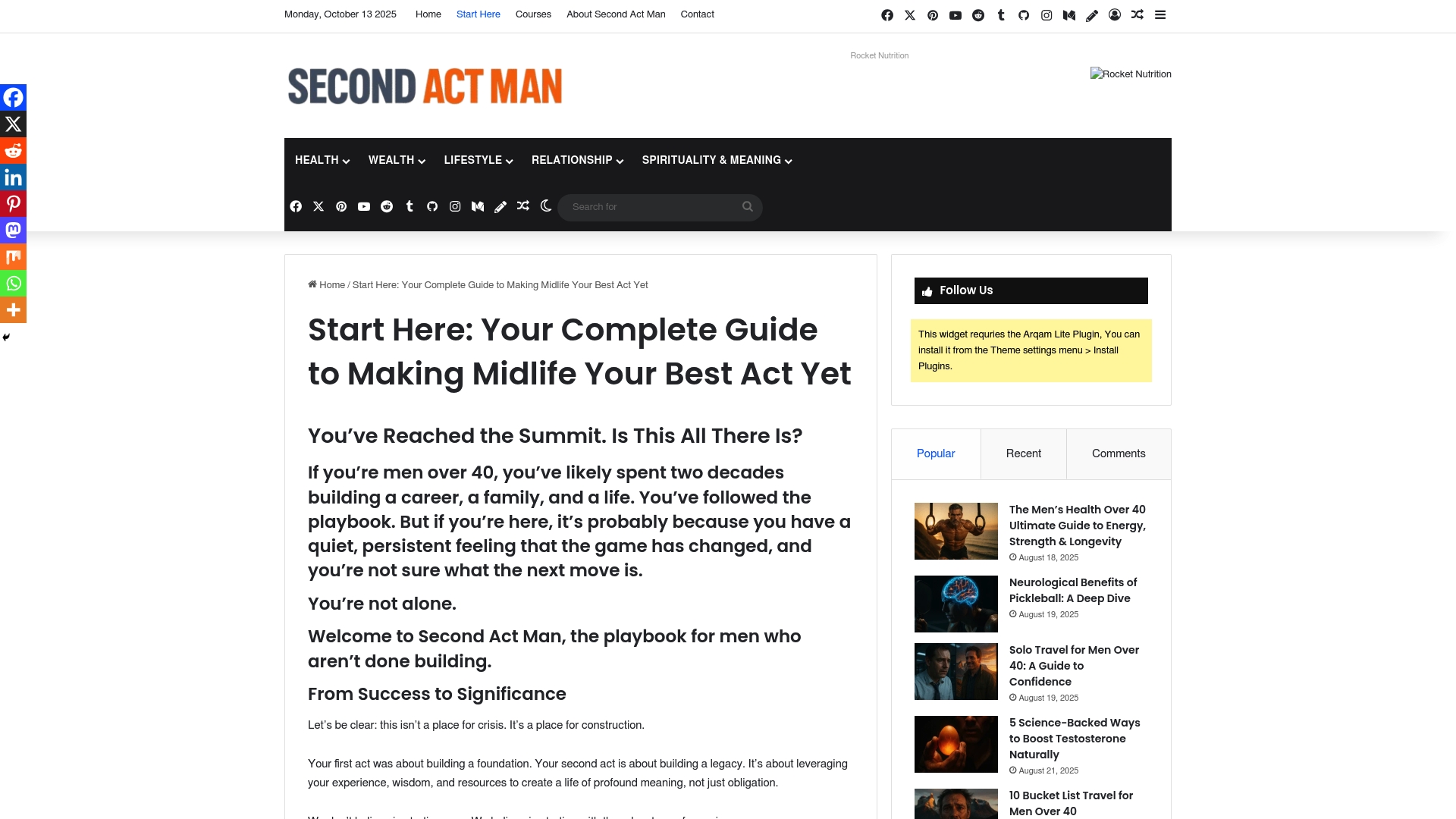Why Network After 40: Complete Guide for Men

Did you know that men’s social networks often decline sharply after age 40, leading to greater feelings of isolation? Building meaningful relationships becomes more challenging just as personal and professional support matter most. For men navigating midlife changes, understanding how to connect with others can open doors to new opportunities, stronger mental health, and lasting friendships. This practical guide shows ways to create purpose-driven networks that support your goals and enrich your life.
Table of Contents
- Defining Networking After 40 for Men
- Key Benefits of Networking in Midlife
- Types of Networking and Their Impact
- Effective Strategies for Building Connections
- Common Mistakes to Avoid When Networking
Key Takeaways
| Point | Details |
|---|---|
| Strategic Networking Focus | Networking after 40 emphasizes building meaningful, purpose-driven connections rather than just collecting contacts. |
| Mental Health Benefits | Engaging in networking can significantly alleviate feelings of isolation and contribute to improved mental health during midlife transitions. |
| Diverse Networking Types | Men should leverage various networking types (professional, social, community) to maximize personal growth and professional opportunities. |
| Avoiding Common Mistakes | Key networking pitfalls include maintaining a transactional mindset and poor follow-up; focusing on relationship-building is essential for success. |
Defining Networking After 40 for Men
Networking after 40 isn’t just about collecting business cards or adding LinkedIn connections. It’s a strategic approach to rebuilding and expanding your social and professional ecosystem during a transformative life stage. Professional networking becomes a deliberate, intentional process of creating meaningful connections that support personal growth, career transitions, and life opportunities.
According to Psychology Today, men’s social networks often dramatically diminish as they age, leading to increased isolation. This makes proactive networking not just beneficial, but essential. The goal shifts from superficial interactions to cultivating deep, mutually supportive relationships that provide genuine value.
- Professional Networking: Strategic engagement through industry events, professional associations, and targeted online platforms
- Personal Networking: Building connections through shared interests, community groups, and personal development circles
- Purpose-Driven Networking: Focusing on quality interactions that align with personal and professional growth objectives
Networking after 40 requires a nuanced approach that goes beyond traditional transactional models. A guide to intentional living can help you understand how to make each connection purposeful and meaningful. It’s about creating a support system that propels you forward, not just collecting contacts.

Key Benefits of Networking in Midlife
Networking in midlife isn’t just a professional strategy—it’s a lifeline for personal growth, mental resilience, and continued relevance in an ever-changing world. Social connections become increasingly critical as men navigate the complex transitions of their 40s and 50s, offering far more than just career opportunities.
According to Kiplinger, maintaining an active professional network can significantly alleviate stress and prevent the isolation that often accompanies midlife transitions. By proactively building meaningful relationships, men can create a support system that provides emotional support, professional insights, and potential collaborative opportunities.
Key benefits of networking in midlife include:
- Career Resilience: Access to job opportunities, industry insights, and potential mentorship
- Mental Health Support: Reducing feelings of isolation and maintaining cognitive engagement
- Personal Growth: Exposure to diverse perspectives and continuous learning experiences
- Emotional Well-being: Creating a sense of community and shared understanding
Research from HealthDay highlights that a broad social network is directly linked to improved mental health and life satisfaction.
For men navigating midlife career reinvention, networking becomes a powerful tool for personal transformation, offering not just professional opportunities, but a renewed sense of purpose and connection.
Types of Networking and Their Impact
Networking isn’t a one-size-fits-all approach. For men over 40, understanding the diverse networking landscapes becomes crucial for personal and professional development. Each networking type offers unique opportunities to expand connections, share knowledge, and create meaningful professional and personal relationships.
Here’s a comparison of the different types of networking and their main impacts for men over 40:
| Networking Type | Main Purpose | Key Benefits |
|---|---|---|
| Professional Networking | Career advancement Skill exchange | Job leads Mentorship Industry insights |
| Social Networking | Personal growth Shared interests | Diverse perspectives Friendship Support |
| Community Networking | Local engagement Giving back | Community impact Expanded circles Purpose |
According to IDEA Fit, networking can be strategically categorized into three primary domains, each serving distinct purposes in a man’s midlife journey:
- Professional Networking: Focused on career advancement, industry insights, and skill exchange
- Social Networking: Building personal connections through shared interests and experiences
- Community Networking: Engaging with local groups, volunteer organizations, and interest-based communities
Research from the National Council on Aging emphasizes the importance of leveraging both online platforms and in-person events. This hybrid approach allows men to create a comprehensive networking strategy that transcends traditional boundaries. For those considering a midlife career reinvention, understanding these networking types can be transformative—providing not just opportunities, but pathways to personal growth and professional renewal.
Effective Strategies for Building Connections
Building meaningful connections after 40 requires a strategic and intentional approach. Professional networking isn’t about collecting contacts, but cultivating genuine relationships that provide mutual value and support. The key is to be purposeful, authentic, and open to opportunities that extend beyond traditional transactional interactions.
According to the National Council on Aging, creating an effective networking strategy involves several critical components:
- Craft a Compelling Personal Narrative: Develop a concise elevator pitch that highlights your unique experiences and value
- Build a Strategic Contact List: Systematically organize and maintain professional and personal connections
- Active Participation: Engage consistently in industry events, workshops, and networking platforms
- Follow-Up and Nurture: Maintain relationships through regular, meaningful communication
Research from Route Networking emphasizes that joining targeted networking groups provides unprecedented opportunities for skill development, mentorship, and professional growth. When approaching relationship building, men navigating midlife career transitions should focus on quality over quantity, creating connections that are both professionally relevant and personally enriching.
Common Mistakes to Avoid When Networking
Networking after 40 requires a nuanced approach that goes beyond basic social interactions. Networking mistakes can significantly undermine your efforts to build meaningful professional relationships, turning potentially valuable connections into missed opportunities. Recognizing and avoiding these pitfalls is crucial for men looking to expand their social and professional circles.
According to IDEA Fit, the most critical networking mistakes men should avoid include:
- Transactional Mindset: Treating connections as purely transactional rather than relationship-building opportunities
- Poor Follow-Up: Neglecting to maintain contact after initial meetings
- Passive Listening: Failing to actively engage and show genuine interest in others
- Self-Centered Communication: Focusing exclusively on personal gains instead of mutual benefits
Research from the National Council on Aging highlights that overcoming networking challenges requires stepping out of your comfort zone. For men navigating midlife career reinvention, the key is approaching networking with authenticity, empathy, and a genuine desire to create meaningful connections that extend beyond immediate professional objectives.
Rebuild Your Network and Purpose After 40
Feeling disconnected or unsure how to build meaningful connections during this life stage is a common challenge for many men. The article highlights how networking after 40 demands a shift from superficial contacts to deep relationships that support both personal growth and career reinvention. If you want to overcome isolation and tap into a network that truly supports your next chapter, you are not alone.
SecondActMan empowers men over 40 to take control of this transformation. We understand the pain points of midlife career shifts, the need for authentic relationships, and the desire for renewed purpose. Explore how to create your personalized roadmap for intentional living and professional success by visiting Start Here for Men Over 40.

Discover proven strategies and supportive community resources designed to help you rebuild your network and rediscover your potential today. Don’t wait until missed connections become lost opportunities. Visit SecondActMan now and begin crafting the meaningful life and relationships you deserve. This is your moment to reinvent with confidence.
Frequently Asked Questions
Why is networking important for men after 40?
Networking after 40 is essential for fostering meaningful connections that support personal growth, career transitions, and emotional well-being, as men’s social networks often decline with age.
What are the main types of networking beneficial for men over 40?
The main types of networking for men over 40 include professional networking for career advancement, social networking for personal growth, and community networking for local engagement and giving back.
How can I build effective connections after 40?
To build effective connections after 40, craft a compelling personal narrative, maintain a strategic contact list, actively participate in networking events, and nurture relationships through follow-ups and meaningful communication.
What common mistakes should be avoided when networking in midlife?
Common mistakes to avoid include having a transactional mindset, poor follow-up practices, passive listening, and self-centered communication that focuses solely on personal gains.
Recommended
- Thrive in Love: Essential Relationship Advice for Midlife Men
- Choosing the Right Multivitamin for Men Over 40: What You Need to Know – Second Act Man
- The Deliberate Man: A Guide to Intentional Living
- Best ED Treatments (2025): Top 4 Online Options Reviewed
- Understanding Weight Loss After 40: Key Concepts Explained – LeanAndFit







